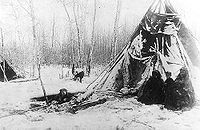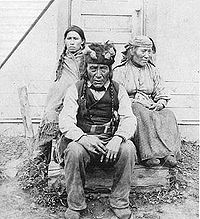
Dunneza
Encyclopedia



Peace River (Canada)
The Peace River is a river in Canada that originates in the Rocky Mountains of northern British Columbia and flows to the northeast through northern Alberta. The Peace River flows into the Slave River, a tributary of the Mackenzie River. The Mackenzie is the 12th longest river in the world,...
of the provinces of Alberta
Alberta
Alberta is a province of Canada. It had an estimated population of 3.7 million in 2010 making it the most populous of Canada's three prairie provinces...
and British Columbia
British Columbia
British Columbia is the westernmost of Canada's provinces and is known for its natural beauty, as reflected in its Latin motto, Splendor sine occasu . Its name was chosen by Queen Victoria in 1858...
, Canada
Canada
Canada is a North American country consisting of ten provinces and three territories. Located in the northern part of the continent, it extends from the Atlantic Ocean in the east to the Pacific Ocean in the west, and northward into the Arctic Ocean...
. About 1,000 Dane-zaa are living today in British Columbia
British Columbia
British Columbia is the westernmost of Canada's provinces and is known for its natural beauty, as reflected in its Latin motto, Splendor sine occasu . Its name was chosen by Queen Victoria in 1858...
and perhaps half speak the Danezaa language
Danezaa language
Danezaa , also known as Tsattine or traditionally as Beaver, is an Athabascan language of western Canada...
.
History
Prior to 1800 the Dane-zaa inhabited lands further east, near the Athabaska and Clearwater rivers, and north to Lake Athabaska, as well as territory north of the upper Peace River. Recent archaeological evidence establishes that the area of Charlie Lake north of Fort St John has been continuously occupied for 10,500 years by varying cultures of indigenous peoplesIndigenous peoples
Indigenous peoples are ethnic groups that are defined as indigenous according to one of the various definitions of the term, there is no universally accepted definition but most of which carry connotations of being the "original inhabitants" of a territory....
.
In the late 18th century, European Canadians opened the Peace River
Peace River
Peace River may refer to the following in Canada:*Peace River , a river in British Columbia and Alberta*Peace River, Alberta, a town in northwest Alberta*Peace River , an electoral district...
area to fur trading. The Cree, a powerful people to the east of the Dane-zaa, had become highly dependent on the European goods and the maintenance of a trade monopoly with North West Company
North West Company
The North West Company was a fur trading business headquartered in Montreal from 1779 to 1821. It competed with increasing success against the Hudson's Bay Company in what was to become Western Canada...
traders (the Northwest Company later amalgamated with the Hudson's Bay Company
Hudson's Bay Company
The Hudson's Bay Company , abbreviated HBC, or "The Bay" is the oldest commercial corporation in North America and one of the oldest in the world. A fur trading business for much of its existence, today Hudson's Bay Company owns and operates retail stores throughout Canada...
). The Scots-Canadian explorer Alexander Mackenzie
Alexander Mackenzie
Alexander Mackenzie, PC , a building contractor and newspaper editor, was the second Prime Minister of Canada from November 7, 1873 to October 8, 1878.-Biography:...
established Rocky Mountain Fort at the mouth of the Moberly River in 1794.
A post journal of 1799-1800 mentions people trading at the post who can be identified as the ancestors of members of the former Fort St John Band, now the Doig River and Blueberry River First Nations. Oral history collected from elders at Doig confirms that the ancestors of present Dane-zaa families were in the upper Peace River area prior to first contact by Alexander Mackenzie in 1793. Traders provisioned their expeditions with bison meat and grease collected by the Dane-zaa in their hunting on the rich prairies of the upper Peace River area. By the time the Hudson's Bay Company took over the North West Company in 1823, bison had become commercially extinct.
For many years the Dane-zaa have followed the teachings and songs of their "Dreamers," who first predicted the coming of the Europeans. The last Dreamer, Charlie Yahey, died in 1976. The Dane-zaa of Fort St John took an adhesion to Treaty 8 in 1900. Today they continue to have a vibrant cultural and economic presence in the North Peace area.
Danezaa First Nations
Treaty 8 Tribal Association- Doig River First Nation (Population: 249)
- Blueberry River First Nations (Danezaa and Cree, Population: 401)
- Halfway River First NationHalfway River First NationHalfway River First Nation is a Dunneza First Nations government with a 3988 ha reserve located 75 km northwest of Fort St. John, British Columbia. It is a Treaty 8 nation....
(Population: 227) - Prophet River First Nation (Population: 223)
- Saulteau First Nations (Saulteau, Danezaa, and Cree, Population: 840)
- West Moberly First NationsWest Moberly First NationsThe West Moberly First Nations is a First Nation located in the Peace River Country in northern British Columbia. They are part of the Danezaa people and language group...
(Danezaa and Cree, Population: 193)
External links
- Doig River First Nation
- Map of Northwest Coast First Nations (including Dunneza)
- http://www.gutenberg.org/ebooks/35659Voyages from Montreal Through the Continent of North America to the Frozen and Pacific Oceans in 1789 and 1793 Vol. II (1903 ed.)
- Living In A Storied Land Royal British Columbia MuseumRoyal British Columbia MuseumThe Royal British Columbia Museum is a natural history and human history museum in Victoria, British Columbia, Canada, founded in 1886. The "Royal" title was approved by Queen Elizabeth II and bestowed by HRH Prince Philip in 1987, to coincide with a Royal tour that year...
- The Dane-Zaa Living Landscape of Northeastern BC Royal British Columbia MuseumRoyal British Columbia MuseumThe Royal British Columbia Museum is a natural history and human history museum in Victoria, British Columbia, Canada, founded in 1886. The "Royal" title was approved by Queen Elizabeth II and bestowed by HRH Prince Philip in 1987, to coincide with a Royal tour that year...

